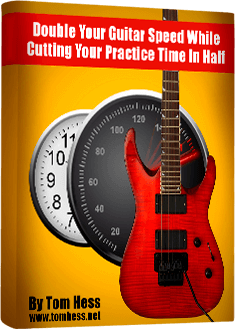Proven 2-Hand Synchronization Tips For Lead Guitar Players
BY AT LEAST 100%

EMAIL TO GET ACCESS
By submitting your info, you agree to send it to Tom Hess Music Corporation who will process and use it according to their privacy policy.
If your lead guitar speed isn’t sounding clean...
...your (lack of) 2-hand synchronization is most often the reason why.
This means your guitar pick is hitting the string a bit before your fretting hand finger frets the note.
(Or vice versa).
This causes you to slow down to a slower tempo where you can keep your hands in sync...
... creating a gap between your maximum top guitar speed and the top guitar speed of your 2-hand synchronization.
BY AT LEAST 100%

EMAIL TO GET ACCESS
By submitting your info, you agree to send it to Tom Hess Music Corporation who will process and use it according to their privacy policy.
And in this article...
... I show you how to improve your 2-hand sync for lead guitar and close the gap between your maximum speed and the speed of your clean playing.
(So you can play guitar fast and sound great when you do it.)
To begin...
... watch this video that shows the key principles of 2-hand synchronization that help you play guitar fast and clean:
Now that you know the basics...
... here are some of the specific ways to practice 2-hand synchronization to improve your lead guitar chops and help you play guitar fast without practicing more:
2-Hand Sync Lead Guitar Practice Tip #1: Practice Unplugged
One of the simplest and most effective ways to improve your 2-hand synchronization and build guitar speed is practicing unplugged.
Why does this work?
When you play guitar unplugged, you instantly hear every flaw in your playing.
Mistakes you might not notice with distortion (due to the compression of the sound of each note) become obvious.
This makes your hands more aware of each other’s timing and helps them stay precisely coordinated and in sync.
Here’s how to practice guitar unplugged effectively:
- Choose a short lead guitar lick or exercise you’re currently working on and play it unplugged at a tempo where you can hear every note.
- As you play, confirm that the hands are in sync and you can hear each note clearly.
- Begin to vary the dynamics of the notes (while staying at the same tempo). Play your lead guitar lick softly, at medium volume and at loud volume (focusing on keeping your 2-hand synchronization under control).
- When you are able to control the dynamics at the slower speed, increase the metronome (by 10-15 bpm) and repeat the process.
If your 2-hand sync breaks down at any point, slow down until you have full control over the notes and practice more at the slower tempo to get your hands in sync.
And when you plug the amp back in...
You’ll notice that it’s much easier to play guitar fast (and increase your guitar speed) thanks to the unplugged guitar practice you’ve done.
Watch this video to see even more guitar practice tips for improving your 2-hand synchronization:
Question: "What if my notes barely sound when I practice unplugged? Should I use more pressure or practice differently?"
Answer: Use a thicker guitar pick (that doesn't flex or bend when you play). And instead of using more force to pick through the strings, use a bit more of the pick to strike the note. Also, make the pick strokes happen quickly (even if the notes sustain for a long time after being picked). This makes your pick attack louder (without requiring more force from your hands to keep your hands in sync).
2-Hand Sync Lead Guitar Practice Tip #2: Accent Every Beat
Another powerful way to improve your 2-hand synchronization for lead guitar is to accent every beat when you practice guitar.
Accenting every beat means slightly emphasizing the first note of each group of notes you're playing. For example, if you're playing a group of four notes per beat, make the first note (of every group of 4) slightly louder than the others.
Why does this help?
Accenting creates clear reference points in your mind and ears. This trains your picking hand and your fretting hand to sync up precisely at each accented note.
The clearer these reference points are, the tighter your 2-hand sync becomes, and the faster and cleaner your lead guitar playing will sound.
Here’s exactly how to practice guitar by accenting each beat:
Step 1: Choose a simple guitar lick or scale run to start with. Make sure it’s a lick you can comfortably play at moderate speed.
Step 2: Set a metronome to a speed slightly below your usual speed, and begin to accent every first note of each beat. Make the accent clear, but don't use excessive force.
Step 3: When you can play the lick in time with the click, speed up the metronome by 10-15 bpm and repeat - continuing to accent each first note clearly.
To be clear: this is just a guitar practice drill. You don’t necessarily need to accent the first note of every beat when playing guitar solos (and it may not be practical when you play guitar fast at very high tempos).
That said, practicing with accents trains your hands to consistently work together. When your hands stay synchronized at slower speeds, they remain in sync more easily when you speed up and start to play guitar fast.
Question: "Tom Hess, what if accenting notes makes me tense?"
Answer: If accenting creates tension, slow down to a lower tempo to make it easier to control your body. A slower tempo gives you more time between notes and makes it easier to relax your hands while making the accents louder than the other notes.

2-Hand Sync Lead Guitar Practice Tip #3: Practice Single String Picking
Playing on a single string makes it harder to keep the hands in sync than playing across several strings.
This is because changing strings gives your hands a brief moment to reset.
On a single string, there is no reset. This gives you instant feedback about your synchronization and makes mistakes more obvious, forcing you to fix them faster than you would otherwise.
As a side benefit, this guitar practice method also helps your fretboard visualization for lead guitar playing.
Here’s how to do it:
Step 1: Choose a scale you already know (like A minor), and play it on just one string. For example, play the A natural minor scale up and down the G string.
Step 2: Play the scale slowly at first (at a tempo where you can easily achieve good 2-hand synchronization), using strict alternate picking. Focus on keeping your pick attack and fretting hand movement perfectly aligned.
Note: you can also accent every beat here, as discussed in the previous section.
For example: accent the first note of every group of 4, I you’re playing the scale in 16th notes. Or, accent the first note of every group of 6 notes if you’re playing sextuplets (16th note triplets).
Step 3: Once that feels easy, increase your speed by 10-15 bpm and continue to listen carefully. The moment your hands fall out of sync, stop and fix the issue before continuing.
Step 4: Create rhythmic variations on the scale, such as playing in groups of 5 or 7 notes. This trains your hands to stay in sync in different rhythmic feels, which makes it easier to play guitar fast and clean in more complex music.
Bonus tip: Use this exercise as a warm-up at the beginning of your guitar practice sessions. This helps to keep your brain engaged, loosens up your fingers and makes all your other lead guitar licks feel easier to play.
Watch this video to learn more about effective guitar practice warm-up drills:
2-Hand Sync Lead Guitar Practice Tip #4: Alternate Open Strings With Fretted Notes
This exercise improves your ability to stay in sync by forcing your hands to adjust to the tension differences between open and fretted notes.
The open string rings differently than a fretted note, so if your timing is off by even a tiny bit, you’ll hear it right away.
When you switch back to fretting a note after playing an open string, your hands must sync up very fast. This contrast reveals any sloppiness in your timing and challenges you to fix it.
Here’s how to practice it:
Step 1: Choose one string to work on. Let’s use the B string for this example.
Step 2: To keep your 2-hand sync exercise sounding in key, choose a scale that has the B note as either the root note or the 5th. One example: E natural minor.
Step 3: Play one fretted note (that is in the key of E natural minor), then one open string. For example: fret the 5th fret, pick it, then immediately pick the open B string.
Step 4: Repeat this slowly, making sure your hands stay in sync. Focus on making each note equally loud, clear, and perfectly timed.
Step 5: Stay at the same tempo and add more fretted notes (from the E natural minor scale). Try playing a short scale sequence where every second note is an open string.
Want to make it even more challenging?
Start the lick on an upstroke instead of a downstroke. This puts your picking hand in a less familiar position and increases the demand on your synchronization.
By combining open strings and fretted notes in your guitar practice, you’ll develop tighter control over your hands, stronger coordination, and better consistency at faster speeds.
2-Hand Sync Lead Guitar Practice Tip #5: Refine Fretting Hand Mechanics
This makes your fretting hand guitar technique more efficient, helping you to sync up both hands when you play guitar fast.
Here are the most important fretting hand guitar technique elements to pay attention to in your guitar practice (that help a lot with guitar speed):
1. Keep your knuckles parallel to the guitar neck when playing guitar scales and arpeggios.
This makes your hand more relaxed and allows the fingers to be open (which makes it easier to play guitar fast and refine your 2-hand synchronization).
2. Avoid pressing the notes down too hard. To understand how much pressure you need, fret any note on any string and begin picking it (using slow tremolo picking).
As you do, release the pressure from the note bit by bit until it stops sounding.
Then, add just a little more pressure back into the string to get a clear note.
Remember that feeling and use it when fretting notes in your lead guitar exercises. (This will help you build a lot more guitar speed.)
3. When releasing notes, don’t use power (tension). Instead, simply release the pressure you were already applying to the string.
This makes it easier to play longer without your fretting hand becoming fatigued.
Watch this video to learn more fretting hand mechanics tips that make your 2-hand sync and guitar speed practice more effective:
Now that you know how to improve your 2-hand sync for guitar, I want to help you master the rest of your guitar playing and become the guitar player you’ve always wished you could be. I can help you with this in my Breakthrough Guitar Lessons.
Here is how it works: first, you tell me about your guitar playing, your strengths and weaknesses, as well as your goals.
Then, I create guitar lessons personalized to you and who you want to become.
And as you practice the lessons, I give you a ton of help, support and personal feedback to help you reach your goals fast, while having fun along the way.
I’ve taught hundreds of guitarists to play at a pro level and can help you too. Click the button on the banner below to begin.

Master your guitar playing by studying guitar online.

